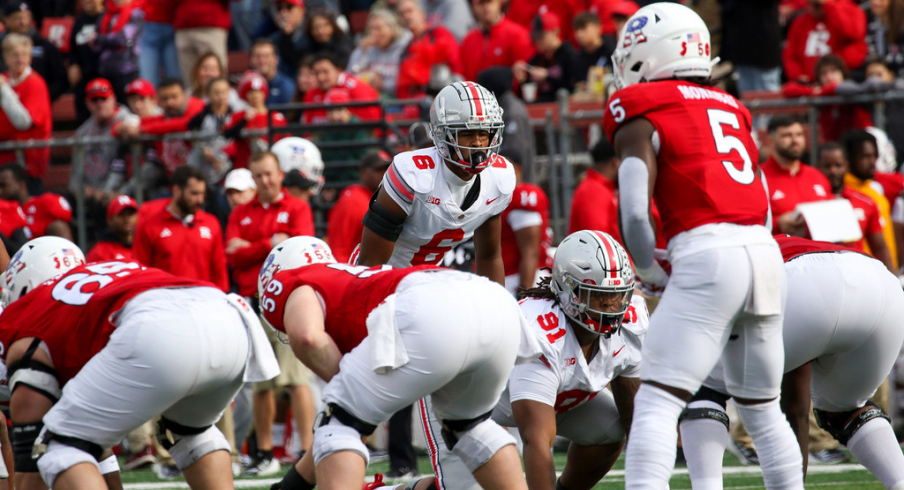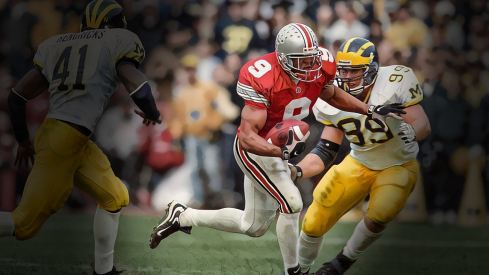While watching the tape of Ohio State's win last weekend in Piscataway, I thought of Nolan Ryan and DeVonta Smith.
I'm sure some of you are wondering what a long-retired pitcher has to do with the Philadelphia Eagles' current #2 receiver, and what either could possibly have to do with a relatively uneventful college football game. Just let me explain, I promise hope it will make sense shortly.
In the days following the Buckeyes' loss to Smith and Alabama in the 2021 CFP title game, I wrote in this very space that then-defensive coordinator Kerry Coombs had become far too predictable in his play-calling, allowing Alabama's OC, Steve Sarkisian, to have a field day in the OSU secondary that night in Miami.
As I wrote in that piece:
Not only did the Crimson Tide seem to know what to expect from the Buckeyes on virtually every snap, but they had a plan to exploit their pass coverage, as quarterback Mac Jones completed 36 of 45 attempts for 464 yards and five touchdowns.
While some of the plays made by Heisman-winning wide receiver DeVonta Smith were the product of his elite speed and excellent hands, many of his 12 catches were made with no defender even within a few yards, allowing him to pick up 106 of his 215 receiving yards after making the catch.
...
Knowing the Buckeyes would play with just one safety in the middle of the field while the other dropped down in the box to fill a run gap, it meant that corners Shaun Wade and Sevyn Banks were effectively left alone on an island against the nation's best player - regardless of whether defensive coordinator Kerry Coombs called for man or zone coverage.
Such a decision left the OSU corners in a lose-lose predicament.
While Coombs' reliance on a stagnant, single-high scheme had been successful at stopping the run all year long, his defense lacked a second pitch to keep offenses on their heels, much the same way Ryan relied on his curveball to keep batters from timing up his devastating fastball. As I also noted in the same piece, Ryan only threw the heater about 60% of the time, mixing in a curveball and change-up that were effective enough to keep batters guessing.
Coombs' full-time successor, Jim Knowles, was given a clear mandate to modernize the approach of the OSU defense upon his arrival. Yet although there was more pre-snap disguise in his first season a year ago, Knowles largely relied upon aggressive, single-high man-coverage and a plethora of blitzes with the players he inherited.
After failing to slow down Michigan or Georgia in the Buckeyes' final two games of the season, Knowles knew he had to evolve his approach and find multiple ways to slow down the opposition. He had to develop a curveball, if you will.
As this season has progressed, the Buckeyes began showing more and more two-high looks, appearing to treat Quarter-Quarter-Half zone scheme (known as Cover 6 to most outside Nick Saban's coaching tree) as the foundation of their game plans.
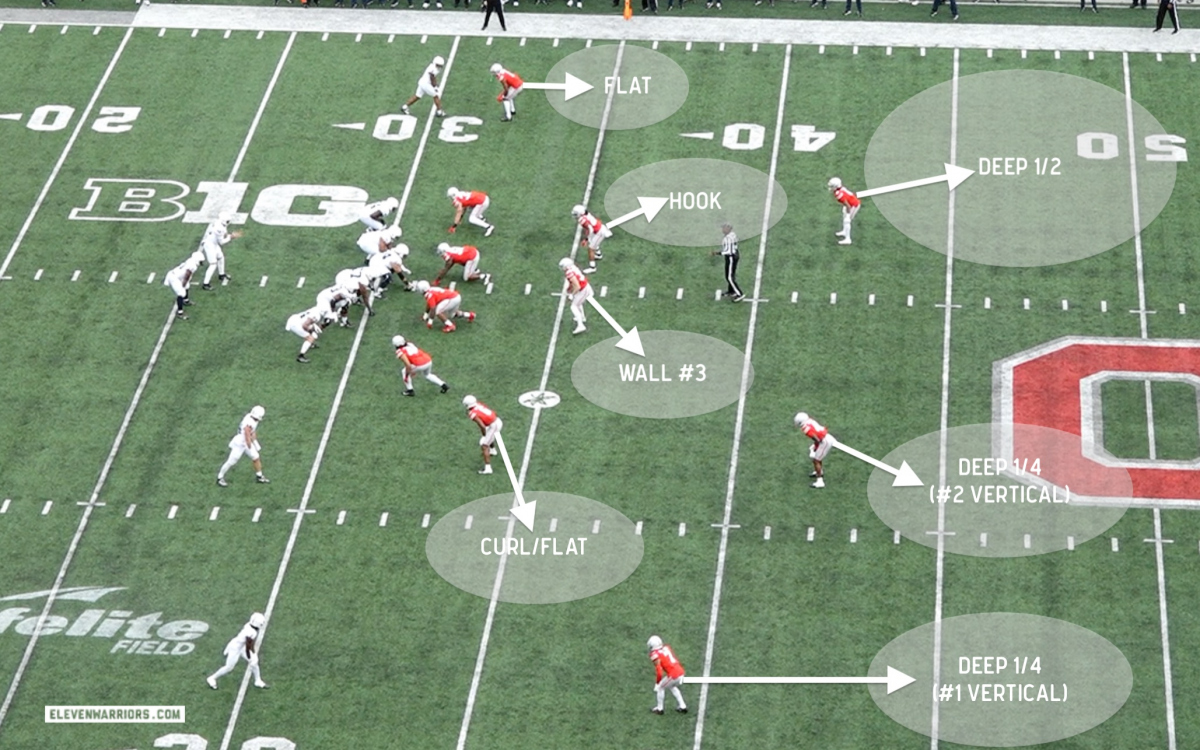
While the scheme appears on its face to be a conservative approach to defending the pass, it proved effective at stopping the run as well. RPO-heavy teams such as Maryland, Purdue, Penn State, and the new-look Wisconsin were often forced into handing the ball off against the light box this look initially presents, only to find a Buckeye safety inserting quickly into the run fit and helping bottle up their ground attack.
As RPO enthusiast Kirk Ciarrocca put together the Scarlet Knights' game plan last week, surely he expected to see more of the same from the Buckeyes. But very quickly, it became apparent that Knowles had something quite different in mind.
Throughout the first half, the Rutgers offense was treated to a steady diet of safety blitzes, as Sonny Styles, Josh Proctor, or Jordan Hancock shot through an interior gap as ends Jack Sawyer and J.T. Tuimoloau set the edges. Most often, the cornerbacks manned up outside receivers while a free safety roamed in the middle of the field behind the blitz.
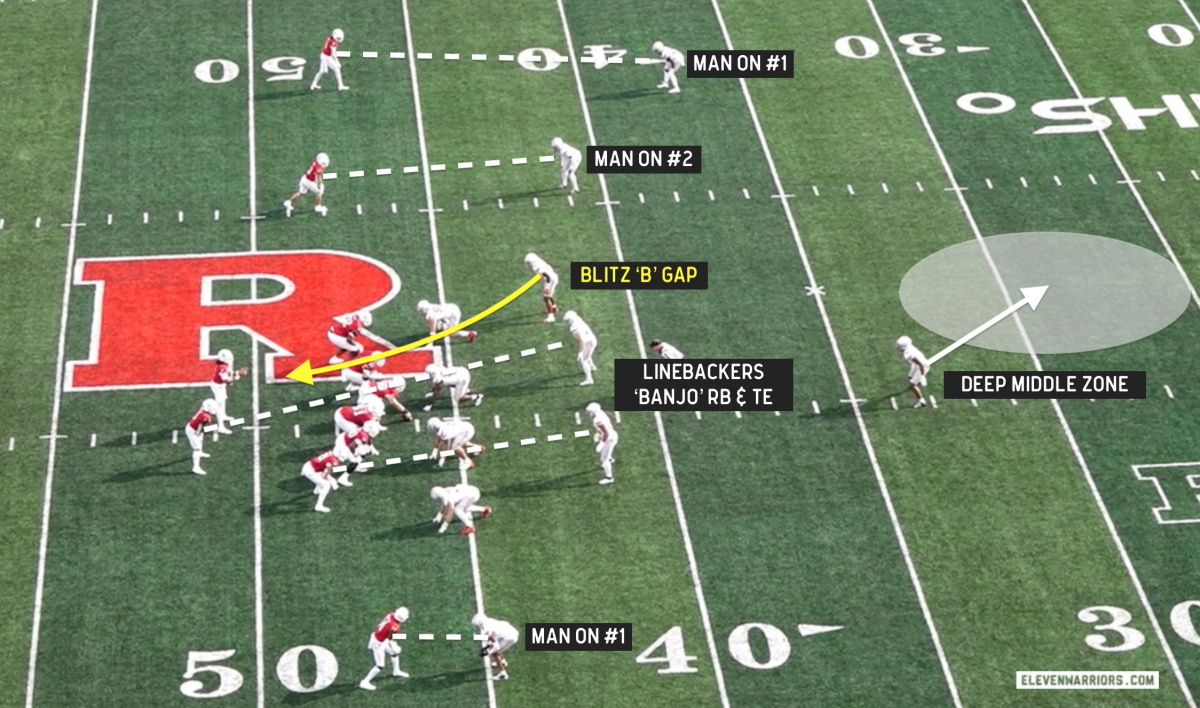
But the primary goal of this blitz wasn't to provide an additional pass rusher, but to stymie the Rutgers run game. Though they lined up with two deep safeties initially, the blitzer created a seven-man box that penned in a Scarlet Knight offense which lined up almost exclusively in 11 personnel (1 running back, 1 tight end).
While Sonny Styles made the most of his opportunity when acting as the blitzer, recording a career-high seven tackles that afternoon, the scheme wasn't meant to inflate the safeties' tackle numbers, either. Instead, the scheme was truly designed to box the Rutgers run game with a defender in every gap, funneling the ball carrier to the middle linebacker.
The 'middle' linebacker in this sense was not always the 'Mike' linebacker, Tommy Eichenberg, but the interior of the three second-level defenders (including the blitzing safety), who is responsible for the A-gap.
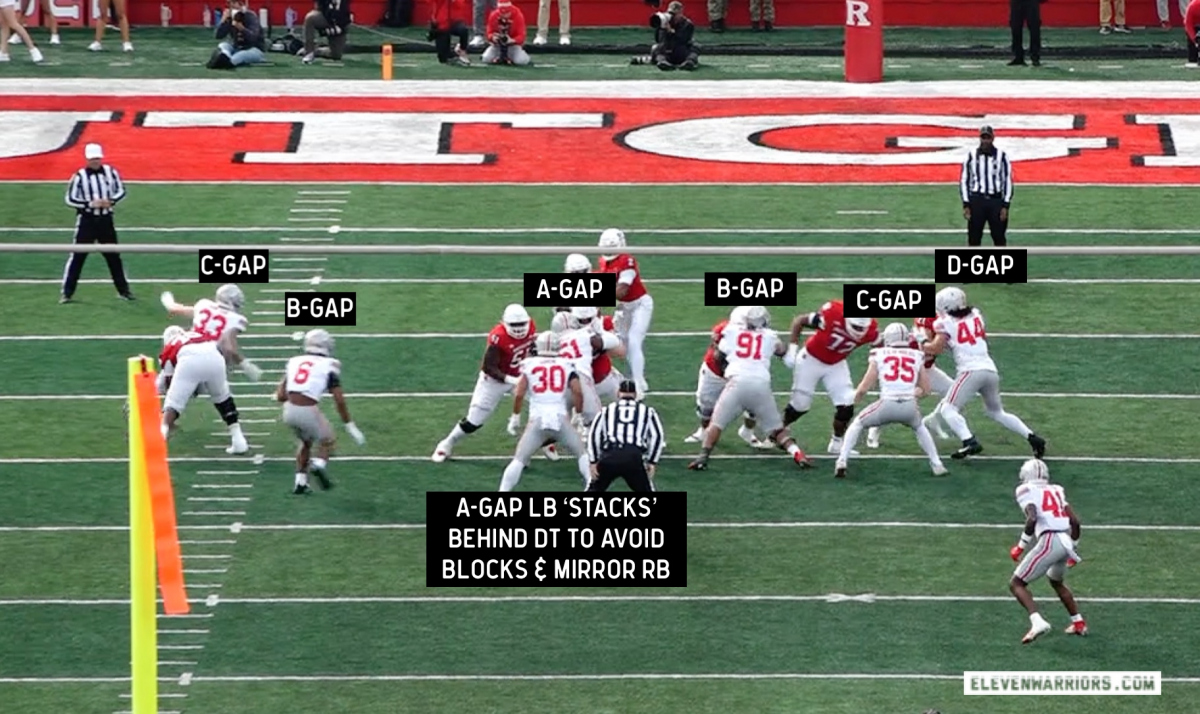
This interior player doesn't simply crash through his gap, instead, he stays back behind the nose tackle who tries his best to occupy a double-team. The offensive line executing the combo block has a more difficult time determining which player should climb to the second level and which should stay with the nose, keeping the linebacker free for an extra beat to mirror the running back being funneled in his direction.
While 'boxing' in a runner like this may seem common (and was so when Coombs was in charge of the defense), it's not how the Buckeyes defended the run just a week prior, when they employed a 'spill' technique that pushed the ball to the edges where an awaiting tackler made the play.
Ohio State is so tough to run at with their aggressive spill overlap techniques vs counter when they played Wisconsin, End comes down gets hands on the tackle, LB overlaps, the safeties there if it bounces outside. 2.4 becomes 4th 1,punts.big stop in game. big change since RU pic.twitter.com/AwL2WwMXV3
— coachkou (@coachkou) November 9, 2023
Even when Ciarrocca mixed things up and called for a gap run such as Power, which pulled a guard right in the direction of the blitzing safety, Styles proved capable of taking on the puller. With the blocker unable to move the safety out of the hole, the 'stacked' 'backer was still able to meet the runner in the A-gap.
Not every safety blitz was planned, however. On a number of occasions, the safety manned up on the tight end (usually Styles or Josh Proctor, depending on the offensive formation) played a Green-Dog technique, in which he read the tight end's movements to determine what to do.
If the tight end released on a pass pattern, the safety simply covered him like normal. But if the tight end blocked the defensive end lined up across from him, the safety triggered a delayed blitz through the C-gap.
While the blitzing safety was most often Styles or Proctor, with the other dropping deep as the free safety, Knowles had a way of bringing his third safety, Jordan Hancock. Lined up in the slot most often, Hancock would fire through the B-gap while Eichenberg blitzed through the A next to him. On the opposite side, the end would drop into zone coverage in this Fire Zone concept.
Hancock's blitzes were relatively rare and would become even more so after what turned out to be the most successful safety blitz of the day.
While Proctor delivered the hit on running back Kyle Monangai that resulted in Hancock's game-changing pick-six, Styles may have played the most important role of all on the play. His pressure forced quarterback Gavin Wimsatt to loft an inaccurate ball off his back foot as #6 in white closed in quickly on a blitz that somehow seemed to catch the Scarlet Knights off guard.
That inaccuracy from Wimsatt was likely the reason Knowles kept calling for these blitzes, as the QB failed to show he could quickly find a receiver when pulling the ball to throw on an RPO, even when Ciarrocca schemed up an open receiver.
After Proctor was injured on the hit that led to Hancock's interception, Knowles clearly scaled back his call sheet with freshman Malik Hartford now forced into duty. Suddenly, the Buckeyes became more predictable, allowing Ciarrocca to start attacking some of the weaker points in the scheme.
The Buckeyes started looking sloppy after spending over 11 minutes on the field during the third quarter. Following Hancock's interception and Proctor's injury, the Scarlet Knights began to pop some chunk plays as the tired defense failed to execute as consistently.
Additionally, Hartford's presence in the game kept Knowles from disguising his intentions as effectively, with Styles almost always acting as the blitzer while Hartford dropped deep. Seeing this, Ciarrocca finally found some success through the air with quick crossing routes that took advantage of the loose coverage outside and filled the space vacated by the blitzing safety.
But once the Buckeyes got up by two scores, Knowles seemed to change his philosophy again, opting for safer, two-deep coverages to defend against the pass. These schemes were fairly vanilla, alternating between Tampa 2 and Quarters coverages, each forcing Wimsatt to be patient and accurate with his throws.
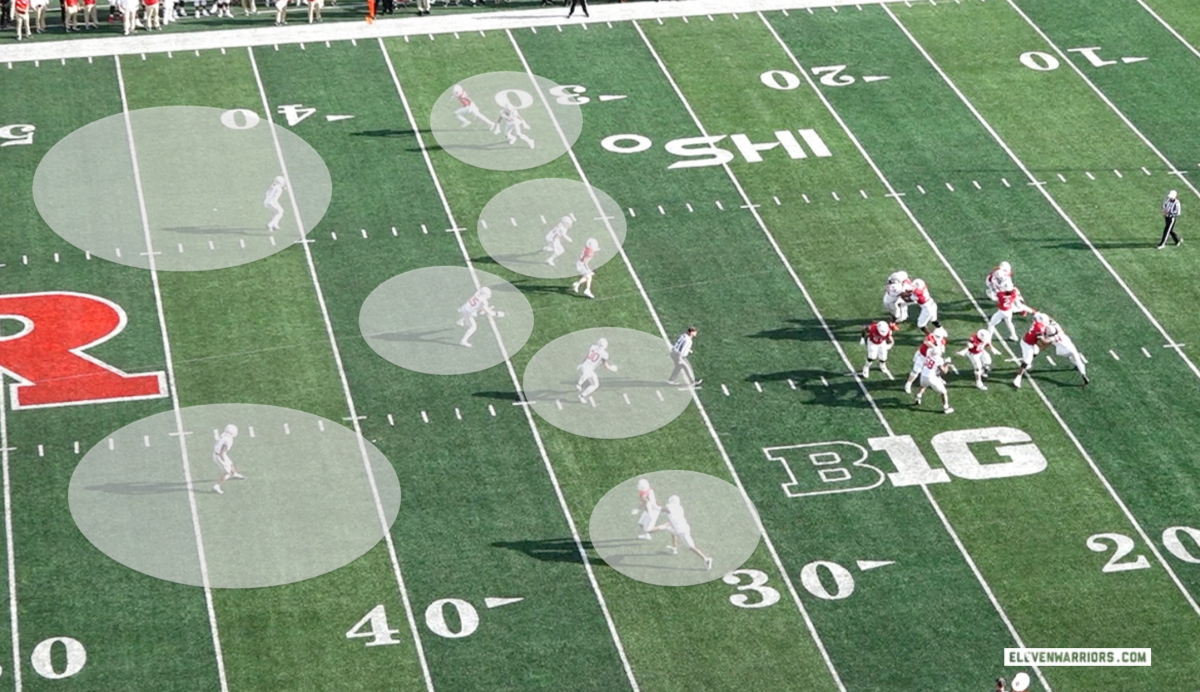
Rutgers would eventually tally 361 yards on the day, the most Ohio State has surrendered all season. However, Knowles' approach made the Scarlet Knights fight for every single one of them.
Outside of the 4th & 1 Fumbelrooski that took the defense by surprise and gained 45 yards, only once did the Buckeyes surrender a gain of 20+ yards all day. That gain came on the first play of the fourth quarter against a unit that was clearly worn down and still adapting to Proctor's notable absence.
While this performance may not have been the finest of the season for Knowles and his team, it stood out to me for a number of reasons.
For one, Knowles showed how he can adapt his approach to the specific talents at his disposal. With Lathan Ransom out with an injury, Styles' more physical skill set was used as a weapon to stack the box and take away the run, rather than forcing him to try and replicate Ransom's role.
But also, Knowles has shown this season that his unit can successfully play a variety of schemes. While the fundamental execution his team exhibits on a weekly basis is certainly the biggest reason his defense is ranked in the top 5 (and the Buckeyes are ranked first in the CFP), he's become a far more difficult opponent to attack in his weekly chess match against the offensive play-caller this season.
For all we know, Knowles may not dial up another safety blitz for the remainder of the season. But now, opposing offenses must keep an eye out for that, along with a variety of other schemes anytime they face the Silver Bullet defense.
Said another way: they can't just look for the fastball anymore.
